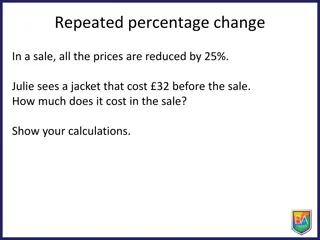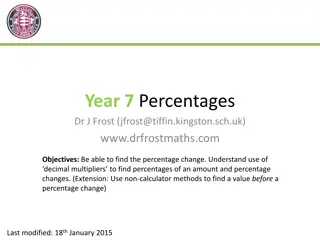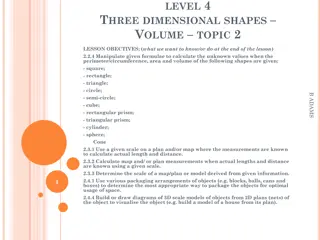Credit Finance Sub-Group and NPRR Updates
Updates from the Credit Finance Sub-Group include discussions on operational NPRRs, new invoice reports, EAL changes, and DC Energy's exposure calculations. The group considered improvements in credit implications, concentration limits, and more. NPRR 1186 was reviewed for enhancements to ESR monito
0 views • 12 slides
Understanding Pharmaceutical Calculations: Altering Product Strength and Solutions
Pharmaceutical calculations involve altering the strength of pharmaceutical preparations by adjusting the proportion of active ingredients, using stock solutions, and problem-solving techniques. This process includes dilution, fortification, and concentration changes to achieve desired product stren
7 views • 23 slides
Disk Performance Considerations and Calculations
Explore examples of disk performance calculations, including seek time, transfer rate, rotational speed, controller overhead, capacity calculations for platters and cylinders, and total disk capacity. Understand how to calculate average time for reading or writing data, number of platters required f
5 views • 5 slides
Physical Science Unit 1 Test Review Game
This test review game covers various topics in physical science including concepts like floating and sinking, forces, work, inertia, acceleration, and more. It presents multiple-choice questions with explanations related to lifeguard tests, object forces, average force calculations, work calculation
1 views • 71 slides
Pharmacy Practice: Percentage and Ratio Strength Calculations
Understanding percentage and ratio strength calculations is crucial in pharmacy practice. Percentages can be expressed as fractions or decimals, and various concentrations like weight-in-volume and volume-in-volume are used in pharmaceutical preparations. Learn how to calculate the correct strength
0 views • 24 slides
Understanding Percentage Increase and Decrease in Mathematics
Explore the concepts of calculating percentage increase and decrease of a number, applying these calculations to various scenarios, and mastering the skills to find any percentage of any amount. Test your knowledge with quick exercises and delve into using strategies to complete tables for practice.
1 views • 24 slides
Understanding Mole Calculations in Chemistry
Explore various mole calculations in chemistry such as determining mass from moles, moles from mass, and comparing particles in different substances. Learn how to calculate the mass of substances, the number of particles, and perform calculations using balanced equations. Dive into concepts like mol
0 views • 49 slides
Water Balance Calculations and Losses Analysis
Water balance calculations involve assessing commercial and physical losses in a water distribution system. The process includes basic calculations, evaluation of commercial losses such as metering inaccuracies and non-revenue water, as well as physical losses like leakage in transmission lines. Add
0 views • 21 slides
Understanding Primary Clarifiers and Surface Area Calculations
Learn about primary clarifiers used to remove particles in water treatment processes with different types and calculations. Dive into surface area calculations for rectangles, including converting inches to feet for accurate measurements. Practice solving surface area problems for practical applicat
7 views • 21 slides
Stock Valuation Analysis and Calculations
The given content discusses various stock valuation scenarios involving dividend payments, growth rates, and required returns on investments. It covers calculations for determining current stock prices, future prices, dividend yields, and required returns based on different company scenarios. Exampl
0 views • 7 slides
Understanding Lattice Constants in Materials Using DFT Calculations
Using Density Functional Theory (DFT) calculations, we explore how to determine the lattice constant of simple cubic, face-centered cubic (fcc), and hexagonal close-packed (hcp) materials. By fitting numerical data and analyzing energy considerations, we predict lattice constants for various metal s
0 views • 17 slides
Understanding Paycheck Calculations in Financial Algebra
Learn about different pay periods, hourly rates, and overtime calculations in financial algebra to ensure accurate paychecks. Explore examples of biweekly, semimonthly, and weekly pay calculations, as well as overtime rates. Understand how to determine annual salaries based on different pay frequenc
0 views • 13 slides
Understanding Percentage Changes and Reversals in Practice
Explore various percentage change scenarios involving increases and decreases, with examples and calculations to help you master the concept. Engage in intelligent practice exercises to sharpen your skills further. Visual aids and step-by-step guidance enhance comprehension.
0 views • 4 slides
Mastering Percentage Changes: Examples and Practice
Dive into the world of percentage changes with worked examples and practice scenarios. Learn how to calculate percentage changes from original values to new values, sharpen your skills, and gain confidence in handling percentage calculations. Explore various scenarios with different numerical values
0 views • 4 slides
Open Heavy-Flavour Production in pp Collisions at the LHC - Physics Seminar Overview
Physics seminar presentation by Francesco Prino on open heavy-flavour production as a function of multiplicity in pp collisions at the Large Hadron Collider (LHC). The talk covers the motivation behind studying heavy-flavour production mechanisms, data analysis techniques, results on the multiplicit
0 views • 65 slides
Mastering Dimensional Analysis for Medication Calculations
Enhance your understanding of Dimensional Analysis (DA) for precise medication dosage calculations with a focus on its practical application in medication administration. Discover the benefits, importance of safety support, evidence supporting DA, and key conversions and abbreviations to remember fo
0 views • 19 slides
Understanding Concentration of Solutions in Physiology
Concentration of solutions is crucial in understanding the properties of substances in Physiology. This involves concepts like percentage solutions and molar solutions, where the amount of solute is measured in grams or moles relative to the volume of the solution. Percentage solutions are commonly
0 views • 8 slides
Accelerating Radiation Therapy Dose Calculations with Nvidia GPUs
Accelerating Radiation Therapy Dose Calculations with Nvidia GPUs by Felix Liu, Niclas Jansson, Artur Podobas, Albin Fredriksson, and Stefano Markidis discusses the utilization of GPU technology to improve efficiency in radiation treatment planning. The process involves creating patient-specific tre
0 views • 18 slides
Repeated Percentage Change Challenges
Explore various scenarios involving repeated percentage changes such as sales, investments, savings, and value depreciation. Test your math skills with calculations, understanding multipliers, predicting outcomes, and debunking misconceptions. Challenge yourself with practical examples to master the
0 views • 8 slides
Pharmacy Principles and Calculations
Explore the fundamental principles and calculations in pharmacy, including calculating weight, volume, specific gravity, and cost of substances like alcohol, glycerin, and acids. Learn about specific volume, percentage strength, and different expressions of concentration in pharmaceutical preparatio
0 views • 17 slides
Geometry Concepts and Calculations Practice Questions
This content covers various topics in geometry, including decimal and fraction conversions, percentage calculations, along with missing angle calculations. It offers practice questions for students to enhance their understanding of geometry concepts.
0 views • 11 slides
Understanding Lighting Calculations for Effective Illumination
Lighting calculations play a crucial role in determining the optimal lighting levels for various spaces. The Lumen Method and Point Calculations help evaluate illumination requirements, while factors like Light Loss Factor and Coefficient of Utilization ensure efficient lighting design. Learn how to
0 views • 13 slides
Understanding Percentage Composition in Chemistry
Percentage composition is crucial in determining the elemental composition of compounds. This lesson explains how to calculate percentage composition using molar masses, illustrated with examples like copper sulfide. It also delves into hydrated salts and their significance in chemistry. Students wi
0 views • 22 slides
Pharmaceutical Measurements and Calculations in Pharmacy
Understanding pharmaceutical measurements and calculations is crucial for pharmacy technicians to prevent calculation mistakes with serious consequences. This article covers the systems of measurement used in pharmacy, including the Metric System, basic math fundamentals necessary for pharmacy work,
0 views • 40 slides
Understanding Percentages - Dr. Frost's Year 7 Math Lesson
Dive into the world of percentages with Dr. Frost in this lesson designed for Year 7 students. Learn how to calculate percentage changes, find percentages of amounts, and solve worded percentage problems. Practice your skills with quickfire questions and exercises to test your understanding. Explore
0 views • 21 slides
Understanding Repeated Percentage Changes in Sales and Investments
This content covers examples and calculations related to repeated percentage changes in sales and compound interest investments. It explains how prices are affected when all items are reduced by a certain percentage in sales, as well as scenarios involving compound interest investments over multiple
0 views • 17 slides
Eleven Plus Examination Practice Questions
A series of challenging practice questions for the Eleven Plus examination are provided, covering topics such as time-distance calculations, percentage calculations, grammar, and logic. Solutions are included for each question to help improve your test-taking skills.
0 views • 22 slides
Understanding Ratio Analysis for Business Performance Evaluation
Ratios in ratio analysis are crucial for analyzing and comparing business performance over time and against other businesses. They are categorized into profitability, liquidity, and efficiency ratios. Profitability ratios like gross profit percentage, net profit percentage, and return on capital emp
0 views • 31 slides
Understanding Degrees of Elasticity of Demand
Elasticity of demand refers to the responsiveness of quantity demanded to changes in price. Perfectly elastic demand occurs when there is an infinite demand at a particular price and demand becomes zero with a slight rise in price. Conversely, perfectly inelastic demand occurs when there is no chang
0 views • 11 slides
Understanding Fair Share and Percentage Changes
Dive into the concept of fair share and percentage changes with practical examples on calculating increases and decreases. Explore scenarios of pay raises, product discounts, and percentage adjustments to enhance your understanding of these math concepts.
0 views • 11 slides
Optimizing Queries and Constructing Percentage Cube in Business Intelligence
Presented at ENSMA, this paper introduces optimized strategies for constructing a percentage cube to enhance processing of complex queries in modern business intelligence. It discusses challenges, comparison between percentage queries and percentage cube, and showcases a data cube analysis of car sa
0 views • 21 slides
Physics Concepts Overview
This content covers various topics such as speed calculations, density, and pressure in physics. It includes examples of speed calculations for different distances and times, density calculations for different substances, and pressure calculations for rectangular sheets exerting force on tables. The
0 views • 7 slides
Pharmaceutical Calculation and Compounding Course Overview
This course provides pharmacy students with a foundation in pharmaceutical calculations including concentration expressions, density, isotonicity, and more. The curriculum focuses on practical skills essential for pharmacy practice. Students will learn how to handle medicinal prescriptions and perfo
2 views • 46 slides
Mastering Percentage Calculations: Mental Math Tricks and Multiplication Methods
Explore mental math tricks and multiplication methods to easily find percentages of numbers. Learn how to convert percents to fractions and use shortcuts for common percentages like 50%, 25%, 20%, 10%, 5%, and 1%. Discover the simple technique of multiplying decimals for accurate calculations. Pract
0 views • 12 slides
Understanding Mole Calculations and Its Applications
Dive into the world of mole calculations with Chapter 5 homework assignments, exploring concepts such as mole weight, the dozen concept, and sweet mole calculations. Discover the significance of moles in chemistry and how they relate to everyday scenarios like calculating the weight of eggs and unde
1 views • 28 slides
Acid-Base Titration Lab Procedure & Calculations
Conduct an acid-base titration experiment to determine the molarity of an unknown NaOH solution using HCl as the titrant. Follow the outlined steps, record data, perform calculations, and analyze the results to understand the principles of this chemical reaction. Learn about indicators, mole ratios,
0 views • 7 slides
Pressure Wave Calculations in Cryogenic Systems
Presentation on pressure wave calculations by R. Rabehl regarding potential differential longitudinal pressure issues in cryogenic systems, specifically related to changing valve positions and their impact on cold masses. The calculations involve dynamic pressure surges using water hammer calculatio
0 views • 6 slides
UK Renal Registry 23rd Annual Report 2019 Data Analysis
The UK Renal Registry's 23rd Annual Report provides comprehensive data on the pathways followed by adult patients to be included in the UK 2019 prevalent ICHD population. The report includes figures on percentage of patients with URR >65%, median URR achieved, changes in URR by sex between 2009 and
0 views • 19 slides
Mastering Volume and Scale Calculations for Three-Dimensional Shapes
Dive into advanced 3D shapes volume calculations and scale manipulations to solve for unknown values using various formulas. Explore packaging arrangements, surface area calculations, and map scale conversions for real-world applications. Practice working with complex shapes like cones, spheres, and
0 views • 8 slides
Math Concepts Explained with Orchard and Length Examples
Learn various mathematical concepts through practical examples involving orchard measurements, length calculations, and percentage calculations. Explore the relationships between side lengths, areas, tree counts, and unit lengths. Understand how to solve equations involving different units of measur
0 views • 8 slides







































